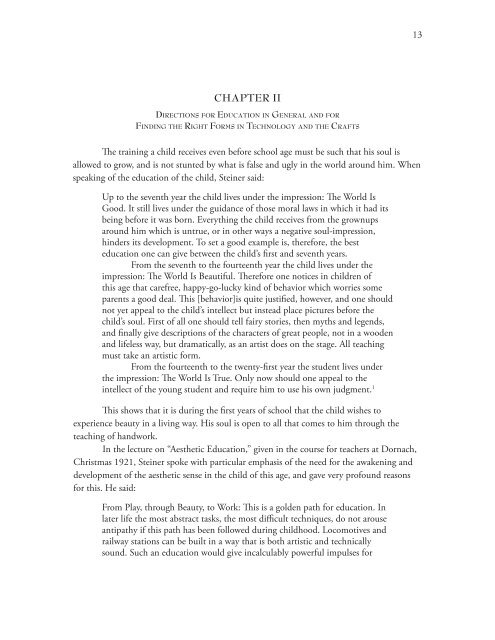Handwork and Handicrafts - Waldorf Research Institute
Handwork and Handicrafts - Waldorf Research Institute
Handwork and Handicrafts - Waldorf Research Institute
You also want an ePaper? Increase the reach of your titles
YUMPU automatically turns print PDFs into web optimized ePapers that Google loves.
13<br />
CHAPTER II<br />
Directions for Education in General <strong>and</strong> for<br />
Finding the Right Forms in Technology <strong>and</strong> the Crafts<br />
The training a child receives even before school age must be such that his soul is<br />
allowed to grow, <strong>and</strong> is not stunted by what is false <strong>and</strong> ugly in the world around him. When<br />
speaking of the education of the child, Steiner said:<br />
Up to the seventh year the child lives under the impression: The World Is<br />
Good. It still lives under the guidance of those moral laws in which it had its<br />
being before it was born. Everything the child receives from the grownups<br />
around him which is untrue, or in other ways a negative soul-impression,<br />
hinders its development. To set a good example is, therefore, the best<br />
education one can give between the child’s first <strong>and</strong> seventh years.<br />
From the seventh to the fourteenth year the child lives under the<br />
impression: The World Is Beautiful. Therefore one notices in children of<br />
this age that carefree, happy-go-lucky kind of behavior which worries some<br />
parents a good deal. This [behavior]is quite justified, however, <strong>and</strong> one should<br />
not yet appeal to the child’s intellect but instead place pictures before the<br />
child’s soul. First of all one should tell fairy stories, then myths <strong>and</strong> legends,<br />
<strong>and</strong> finally give descriptions of the characters of great people, not in a wooden<br />
<strong>and</strong> lifeless way, but dramatically, as an artist does on the stage. All teaching<br />
must take an artistic form.<br />
From the fourteenth to the twenty-first year the student lives under<br />
the impression: The World Is True. Only now should one appeal to the<br />
intellect of the young student <strong>and</strong> require him to use his own judgment. 1<br />
This shows that it is during the first years of school that the child wishes to<br />
experience beauty in a living way. His soul is open to all that comes to him through the<br />
teaching of h<strong>and</strong>work.<br />
In the lecture on “Aesthetic Education,” given in the course for teachers at Dornach,<br />
Christmas 1921, Steiner spoke with particular emphasis of the need for the awakening <strong>and</strong><br />
development of the aesthetic sense in the child of this age, <strong>and</strong> gave very profound reasons<br />
for this. He said:<br />
From Play, through Beauty, to Work: This is a golden path for education. In<br />
later life the most abstract tasks, the most difficult techniques, do not arouse<br />
antipathy if this path has been followed during childhood. Locomotives <strong>and</strong><br />
railway stations can be built in a way that is both artistic <strong>and</strong> technically<br />
sound. Such an education would give incalculably powerful impulses for

















